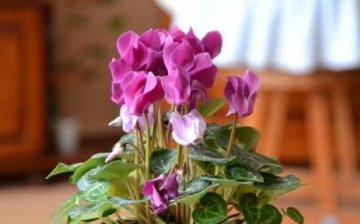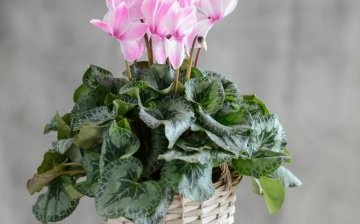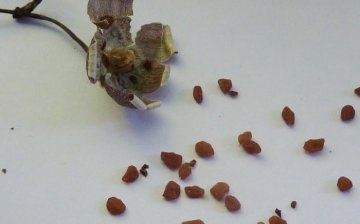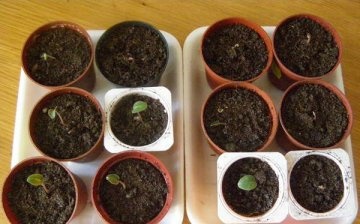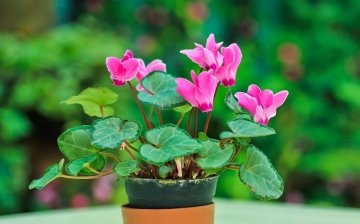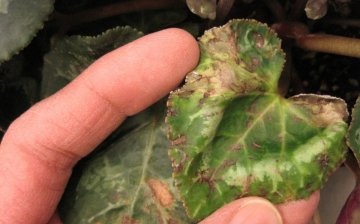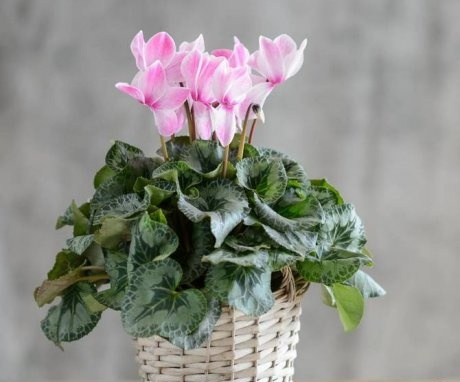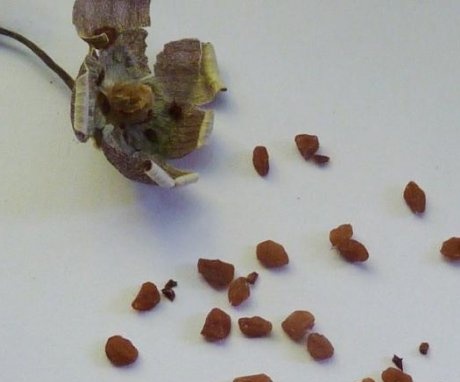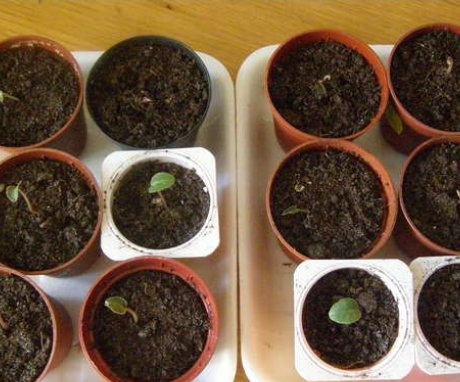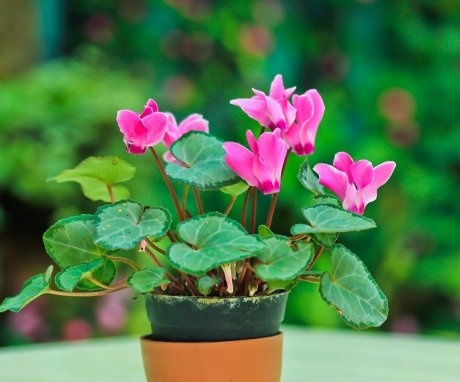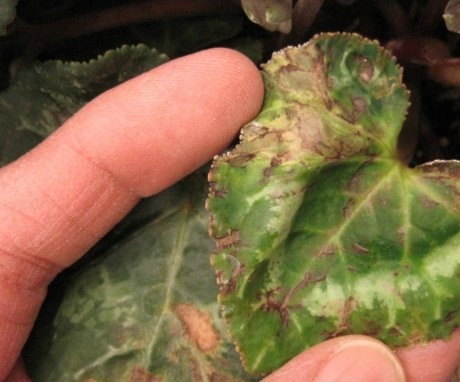Cyclamen: how to grow a flower from seed
In the winter season, when hurricanes are raging outside the window, hills of snow turn white, it is nice to have a colorful corner of flowering plants at home. Such bright representatives of decorative indoor flowers include cyclamen.
In nature, cyclamens grow in the Mediterranean part of Europe and Iran. They are perennials that delight with their colorful flowers from late autumn to early spring. Florists grow them at home, getting not only a wonderful oasis in the middle of winter, but also a valuable medicine.
Content:
- Indoor plant description
- Seed, soil and container preparation
- Landing: timing and rules
- How to properly care for a flower
- Fight against diseases and pests of cyclamen
Indoor plant description
Cyclamen, or the alpine violet, is easily recognized by its long-stemmed pink to purple flowers. The leaves that look like hearts are cast in silver on top, and are painted in a dark red tone from below. Looking at the plant, it seems that this beautiful Spanish woman flaunts with a proud posture in front of the audience. Her silvery puffy skirt accentuates her slender waist with a bright headdress.
The European type of flower has small inflorescences, but the Persian is characterized by large, butterfly-like petals with white, pink shades. They spread a pleasant smell far. The root of the plant is a tuber of both oval and flat shape.
The cyclamen begins to bloom in mid-autumn, and ends at the end of the winter season.
Each flower lives up to ten days, giving way to its fellows. The seeds of the plant are similar to buckwheat grain, they are collected in a miniature box. In spring, the flower hibernates, since the tuber lives and breathes above the ground, and the leaves and stems freeze for a while. Cyclamen propagation methods - tubers and seeds. The second method is most commonly used. The seeds of the plant are purchased in a specialized store or harvested on their own from an indoor flower.
Seed, soil and container preparation
Basic rules of preparation:
- Seed material is shaken out of dry bolls and soaked in water before sowing, to which Epin-extra or Zircon is added to stimulate growth. The drug is diluted as follows: four drops in half a glass of liquid. After twelve hours, you can spread the seeds on a moistened cotton pad, covering with a damp bandage. After a day, the seeds will swell and will be ready for sowing.
- The soil for an indoor flower should be loose, nutritious, well permeable to air and water. It can be a commercially available substrate specifically for decorative floriculture. Preparing the soil yourself is not difficult. It is necessary to mix the garden soil with peat, adding a little river sand. Steaming the soil is mandatory. It is spilled with boiling water or kept in the oven for several minutes. Disinfection produced two weeks before planting seeds.
- For a container for planting, choose either small flower pots or plastic containers. Holes must be made in them to remove excess moisture. A drainage layer is laid at the bottom, collected from pieces of foam plastic, fine expanded clay, clay shards.
Many people try to germinate the seeds first, so that they can then be planted in pots. To do this, place the material on the moistened gauze, covering them with a layer of fabric on top. Then, a day later, the seeds are planted in a container at a distance of three centimeters, sprinkling them with a little soil. The containers are placed in a dark place, constantly moistening the ground.
As soon as shoots appear, the pots are placed on light-colored windowsills. After three months, the overgrown small flowers can be repotted, each in a separate container. Small pale purple sprouts require a sensitive attitude towards themselves.
Landing: timing and rules
So, the seed pots were in the dark and cool, they sprouted quickly, within a month, at a temperature not lower than ten degrees and not higher than twenty. Too hot a place not for sprouts, otherwise they will appear much later.
Sowing dates play an important role in the beginning of flowering of alpine violets.
By planting them at the end of June, you can be sure that the plant will bloom in the fall. Planting in August will result in a late blooming season. Covering the top of the landing is optional. If this measure is taken, then it will be necessary to air them daily. The main maintenance requirements at this time are soil moisture. Better to do watering using a pipette, delivering moisture to the root of the plant.
Transplant a flower is possible when three or four leaves have appeared. Perform the procedure carefully, trying not to damage the nodules. We must not forget that the root system must be above the soil. Deep deepening can destroy the plant. If this happens, then the top layer of the soil is removed, exposing the tubers. After picks the aerial part of the alpine violet begins to actively develop. Six months after sowing cyclamens, they take on a real adult appearance.
And here comes the time for feeding the houseplant. Effective will mineral fertilizers or universal complexes for decorative flowers. Proper watering is also important for the formation of a rosette of leaves and inflorescences. It is important that the liquid does not get on the tubers, otherwise decay will occur. root system... If the plant gains strength a year after sowing, then this indicates that the cultivation procedure was successful.
How to properly care for a flower
Cyclamen care rules are simple:
- A comfortable place for a flower will be one where the sun's rays do not shine so brightly. He prefers diffused light, partial shade. The room should be well ventilated, but without drafts, which are contraindicated in cyclamen.
- Being a cold-loving plant, the flower does not like heat. It blooms well at temperatures between fourteen and sixteen degrees above zero.
- During the dormant period, the pot with the plant can be transferred to the basement, but with sufficient lighting.
- High air and soil humidity are ideal conditions for a flower. But when watering, you need to be careful. It is best to water through the tray containing the plant pot. It is necessary to change the water in it daily. Drops of liquid should not fall on the stem, tubers, flowers, otherwise they will rot. Water for irrigation is taken only at room temperature with preliminary settling.
- During the watering procedure, it is recommended to make fertilizersspecially selected for flowering plants. You should not get carried away with nitrogenous fertilizing - the foliage will grow, and the flowering will stop.
- During the rest period, dry leaves and flowers are cut off from the cyclamen. The strong parts are cut closer to the roots. Watering is reduced, slightly moistening the soil.
- In the summer, the alpine violet is transplanted into a larger pot, leaving a third of the tubers above the ground. Watering begins ten days after the procedure.
Observing all the recommendations for caring for cyclamen, you can achieve its long flowering.
Fight against diseases and pests of cyclamen
To the main ailments cyclamen include fungal diseases caused by improper care:
- Abundant watering, waterlogging causes the appearance of gray rot on the tubers. If a pathology is detected, the plant is carefully dug out, the infected root areas are cut off, then washed in a solution of potassium permanganate. After drying the tubers, the cyclamen is planted in a new pot with pre-steamed soil.
- A flower gets sick with root rot if it has been infected with fungal pathogens that live in the ground. This ailment strikes when planting seeds in non-steamed soil. You can get rid of the disease with the help of fungicides such as Glyocladin, by treating plants with them. And the tubers must be thoroughly rinsed in a disinfectant solution and dried.
- Sooty fungi clog the stomata and ducts of leaves, destroying them. Fungal plaque on the plates must be washed off with a solution of green soap, then rinsed with warm water. Spraying with Bordeaux liquid will also help.
- Peduncles can also be damaged by fungi. From this they will deform, dry out. Damaged flowers are removed and cyclamen is sprayed Topaz.
Indoor flower pests:
- Of the pests, it is especially dangerous for alpine violets. aphid, the colonies of which feel comfortable on the leaves of the plant. Sucking the juice out of them, the pest destroys the flower that dries up before our eyes. The violet will be saved by washing the affected parts with a solution of laundry soap.
- Small thrips are completely invisible, but their traces remain on the leaf blades with white grooves. Parasites love high humidity and heat. In this case, the leaves acquire a whitish color, then darken and fall off. Suitable for the destruction of the insect Karbofos. The folk method includes spraying with infusion garlic - two cloves in a glass of boiling water.
- The tick also likes to settle on cyclamen, affecting leaves and flowers. Insecticidal preparations Fitoferm, Neoron can rid the plant of it. It is necessary to spray them not only the flower, but also the soil, the pot.
The health of a houseplant is in the hands of its owner.
More information can be found in the video:



